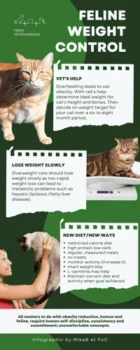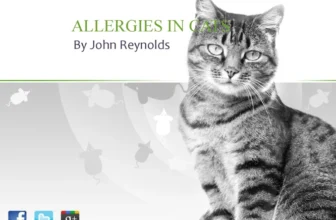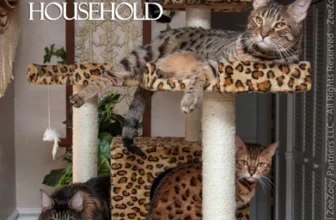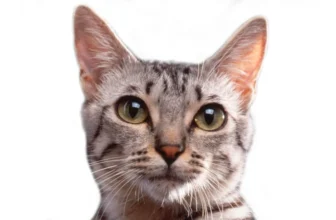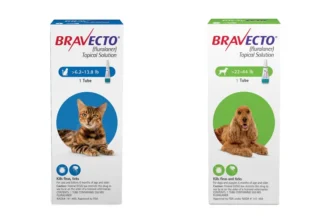It’s no secret that cats love to lounge around and nap all day, but what happens when this sedentary lifestyle leads to obesity in your California Spangled cat? Obesity can have serious health consequences for your furry friend, including an increased risk of diabetes and heart disease. But preventing obesity in California Spangled cats is easier than you might think. With simple changes to their diet and exercise routine, you can help your cat stay healthy and happy for years to come. Let’s take a closer look at how to prevent obesity in California Spangled cats through proper diet and exercise.
Why Obesity is Dangerous for California Spangled Cats
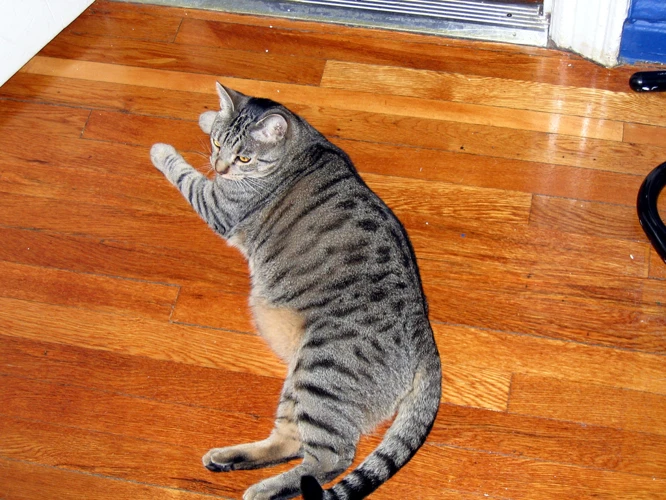
Obesity is not only a human problem, and California Spangled Cats are no exception. While it can be tempting to give in to your feline’s love of food and treats, allowing them to become overweight can be dangerous for their health and well-being. The risks associated with obesity in California Spangled Cats can be serious, affecting both their physical and behavioral health. It’s important to take action to prevent obesity in your furry friend and ensure they will live a long and happy life. Let’s explore the potential health risks of obesity in California Spangled Cats. Don’t forget to schedule regular vet checkups to ensure your cat’s optimal health. You can find more information about their importance in our article “Importance of Vet Checkups for Your California Spangled Cat”.
Health Risks of Obesity
Obesity is an epidemic among pets, and California Spangled Cats are no exception. Obesity can lead to numerous health problems, including diabetes, heart disease, and joint problems.
Diabetes occurs when the body either doesn’t produce enough insulin or can’t utilize the insulin it produces effectively. Obesity can lead to insulin resistance, making it difficult for the body to use the insulin it produces. This can result in high blood sugar levels, which can cause damage to the kidneys, eyes, and nerves.
Heart disease is another major health risk associated with obesity. When a cat is carrying excess weight, its heart has to work much harder to pump blood throughout the body. Over time, this extra strain can lead to hypertension, enlarged heart muscles, and eventually heart failure.
Joint problems can also arise in overweight cats, particularly those with extra weight in their abdomen. This puts a lot of pressure on the joints, which can lead to arthritis and other joint-related issues.
It’s important to note that these health risks do not occur in a vacuum. Obesity can also lead to behavioral problems in cats, such as lethargy, depression, and even aggression.
As an owner, it’s crucial to keep an eye out for these health risks. By maintaining a healthy weight for your California Spangled Cat, you are not only helping them to live a happier, more active life, but also preventing a host of related health issues. Regular check-ups with your veterinarian are crucial for monitoring your cat’s health and ensuring that they are at a healthy weight.
For more information on caring for your California Spangled Cat, check out our articles on dental tips, parasite prevention, and flea and tick prevention.
Behavioral Risks of Obesity
Obesity doesn’t just pose a threat to the physical health of California Spangled cats, it can also affect their behavior. One of the main behavioral risks of obesity is decreased activity levels, which can lead to a decrease in mental stimulation and an increase in lethargy. This can cause cats to become more sedentary and may lead to decreased playfulness and general activity.
Another behavioral risk of obesity is an increased risk of depression. When cats are overweight, they may not be able to engage in activities they used to enjoy, leading to decreased motivation and moodiness. In some cases, overweight cats may even begin to lose interest in socializing with other cats or their owners.
Obesity can also lead to increased stress for cats. For example, if a cat is struggling to groom themselves properly due to their weight, this can become a major source of stress and frustration. Over time, this can lead to negative behavioral changes, including increased aggression and other destructive behaviors.
In order to prevent these negative behavioral consequences, it’s crucial to maintain a healthy weight for your California Spangled cat. This means ensuring they are eating a healthy diet and are getting plenty of exercise and mental stimulation. By doing so, you can help your cat remain happy, healthy, and active for years to come.
Proper Diet for California Spangled Cats
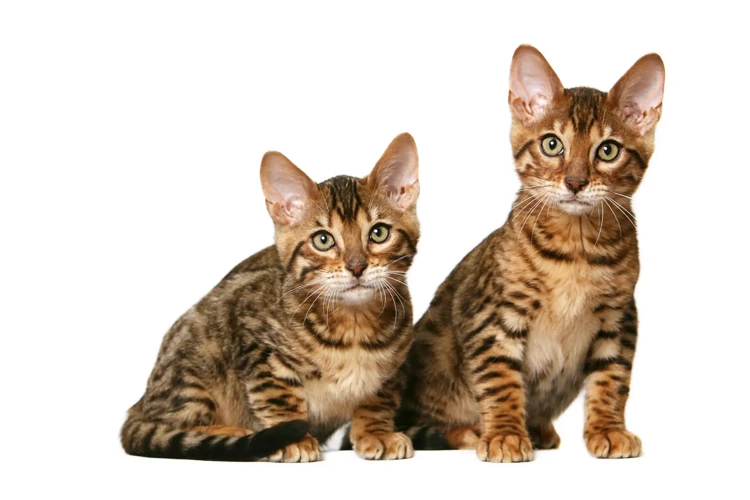
When it comes to ensuring the health and well-being of your beloved California Spangled cat, proper nutrition is key. As with humans, a healthy diet is essential for maintaining the right weight and avoiding the risks of obesity. But what exactly makes up a proper diet for these beautiful felines? In this section, we’ll explore the most important factors to consider when it comes to feeding your California Spangled cat. From choosing the right food to portion control and feeding schedule, we’ll cover everything you need to know to help your furry friend stay healthy and happy.
Choosing the Right Food
When it comes to preventing obesity in California Spangled cats, choosing the right food is crucial. A cat’s diet should consist mainly of high-quality protein, with a low percentage of carbohydrates and fat. Commercial cat food brands often pack their products with fillers and preservatives that can be harmful to your cat’s health. It’s essential to read the ingredients list on the cat food packaging to ensure that it meets your feline friend’s nutritional needs.
To help you choose the right food for your California Spangled cat, we have created a table comparing the nutritional content of some popular cat food brands:
| Brand | Protein % | Carbohydrates % | Fat % | Ingredients to avoid |
|---|---|---|---|---|
| Hill’s Science Diet | 32% | 37% | 19% | Corn, wheat gluten, soybean meal, by-product meals |
| Blue Buffalo | 34% | 15% | 18% | Corn, wheat, soy, by-product meals, artificial preservatives |
| Purina Pro Plan | 40% | 10% | 16% | Corn, wheat, soy, by-product meals |
| Orijen | 42% | 20% | 20% | No artificial preservatives, grains, fillers, by-products |
As you can see, Orijen has the highest amount of protein and the lowest amount of carbohydrates, making it a great choice for your California Spangled cat’s diet. When choosing cat food, also keep in mind that some cats may have food allergies or sensitivities to common ingredients like chicken, grains, or fish. Always consult with your veterinarian about any dietary restrictions or recommendations for your cat.
Remember, a healthy diet is just one part of preventing obesity in California Spangled cats. You should also pay attention to portion control, treats, and feeding schedules. By following these guidelines, you can help your furry friend maintain a healthy weight and live a happy, active life.
Portion Control
A crucial aspect of preventing obesity in California Spangled Cats is proper portion control. This involves ensuring that your cat consumes the recommended amount of food per day, based on their age, weight, and activity level. Overfeeding your cat can lead to weight gain and increase the risk of obesity-related health issues.
How to Measure Portions
One way to control portions is to use a measuring cup or a kitchen scale to measure the amount of food your cat consumes. Follow the manufacturer’s guidelines on the food packaging for the recommended daily serving size. You can also consult your veterinarian for recommended portion sizes specific to your cat.
Another method is to visualize portion sizes using an easy-to-follow table. This table shows the recommended portion sizes for dry and wet food for cats of different weights:
| Cat Weight | Dry Food | Wet Food |
|---|---|---|
| 4 lbs | 1/4 cup | 1/4 can (3 oz) |
| 8 lbs | 1/2 cup | 1/2 can (6 oz) |
| 12 lbs | 3/4 cup | 3/4 can (9 oz) |
| 16 lbs | 1 cup | 1 can (12 oz) |
Factors that Influence Portion Sizes
Keep in mind that portion sizes may vary depending on your cat’s age, activity level, and any health issues they may have. For example, older cats may require smaller portions due to their decreased activity level, while kittens may require more food to support their growth and development.
Additionally, if your cat tends to be more active, they may require more food to fuel their energy. Conversely, if your cat is more of a couch potato, they may require fewer calories.
It’s essential to monitor your cat’s weight regularly and adjust their portion sizes accordingly. If your cat has gained weight, reduce the portion size or switch to a lower-calorie food. However, if your cat is losing weight, consider increasing the portion size or switching to a higher-calorie food.
Proper portion control is a critical aspect of preventing obesity in California Spangled Cats. By following the recommended portion sizes and adjusting as necessary, you can help keep your cat at a healthy weight and reduce their risk of obesity-related health issues.
Treats
Giving treats to your California Spangled cat is a great way to show your affection and bond with them. However, it is important to remember that treats should only make up a small portion of their diet. Here are some tips on giving treats to your cat in a healthy and responsible way:
Choose the Right Treats
Not all treats are created equal. When selecting treats for your California Spangled cat, make sure to choose ones that are specifically designed for their nutritional needs. Look for treats that are low in calories and high in protein. Avoid treats that are high in carbohydrates or artificial ingredients.
Here are some examples of healthy treats for your cat:
| Fish or chicken-flavored treats | Freeze-dried meat | Cat grass |
| Small pieces of cooked chicken or fish | Small pieces of cheese | Catnip toys |
Control Portion Sizes
Just like with their regular food, it is important to monitor the amount of treats you give your California Spangled cat. Overfeeding on treats can lead to excessive weight gain and obesity. Follow the recommended serving size on the packaging of the treats you purchase.
Use Treats as Rewards
Treats are a great way to reward your cat for good behavior or as a training tool. Try calling your cat’s name or teaching them a new trick with the help of treats. However, make sure not to give too many treats at once, as this can have the opposite effect and encourage bad behavior.
Consider Making Homemade Treats
Another great way to give treats to your California Spangled cat is by making your own at home. This allows you to have complete control over the ingredients and portion sizes. However, make sure to do your research and only use ingredients that are safe for cats. Avoid using ingredients that are toxic to cats, such as chocolate or garlic.
By following these tips, you can treat your California Spangled cat while still maintaining their health and wellbeing. Remember, a healthy diet is the foundation of preventing obesity in cats, so treats should only be given in moderation.
Feeding Schedule
Creating a feeding schedule is essential in preventing obesity in California Spangled cats. Free feeding or leaving food out all day long is not recommended as it can lead to overeating and weight gain. Instead, it’s better to establish a consistent feeding schedule that you can stick to.
One way to schedule cat meals is to divide the daily ration of food into several small meals throughout the day. You can offer your cat breakfast, two or three small meals during the day, and dinner. This ensures that your cat is not overeating at any given meal.
An alternative feeding schedule is to offer two main meals per day. This involves offering a portion of food in the morning and another in the evening. Be sure to choose a time that works best for you and your cat.
When establishing a feeding schedule, it’s important to stick to the schedule as closely as possible to avoid overfeeding or underfeeding your cat. Also, monitor your cat’s food intake to make sure they eat the recommended amount of food for their weight and age.
It’s also important to provide fresh water at all times. You can do this by placing a water bowl in various locations throughout your house–including the areas where your cat spends most of their time.
By following a consistent feeding schedule and monitoring your cat’s food intake, you can ensure that your California Spangled cat maintains a healthy weight and avoids obesity.
Exercise Tips for California Spangled Cats
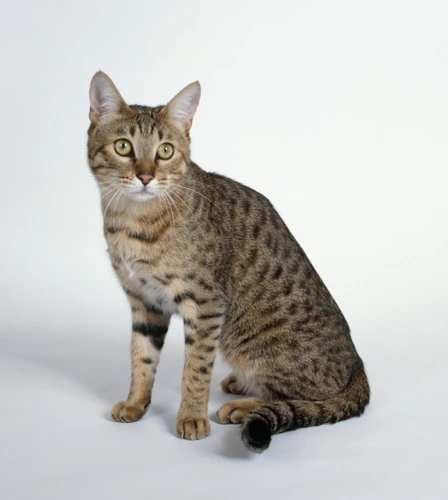
When it comes to keeping your California Spangled Cat healthy, diet is just one part of the equation. Exercise is also crucial to maintaining their physical and mental wellbeing. However, as independent creatures, getting these felines to exercise can be a challenge. But don’t worry, there are plenty of ways to help your California Spangled Cat stay in shape and have fun at the same time! From laser pointers to outdoor adventures, let’s explore some paw-some exercise tips.
Laser Pointers and Toys
Playing with laser pointers and toys is a fun and interactive way to incorporate exercise into your California Spangled cat’s daily routine. Laser pointers are especially useful for cats who like to stalk and pounce, as it simulates hunting prey. Here are some tips for using laser pointers and toys to prevent obesity in California Spangled cats:
- Position yourself and the laser pointer or toy in a large, open space to allow for your cat to run and pounce.
- Always supervise your cat to ensure they don’t accidentally hurt themselves while playing.
- Use different types of toys, such as feather wands or mouse toys, to keep your cat mentally stimulated and engaged.
- Rotate the toys to avoid boredom.
- Use the laser pointer or toy for short play sessions, rather than extended periods of time, to prevent exhaustion and reduce the risk of injury.
- Incorporate frequent breaks during playtime to allow your cat to catch their breath and rest.
Laser pointers and toys can be an effective way to promote physical activity in California Spangled cats, but it’s important to remember to use them in moderation and always supervise your cat during playtime. With these considerations in mind, you can make playtime fun and engaging for your cat while helping to prevent obesity.
Cat Trees and Scratching Posts
Providing your California Spangled Cat with a variety of cat trees and scratching posts is a great way to keep them active and prevent obesity. Not only do these items encourage cats to climb and scratch, they also provide mental stimulation and a place to rest.
Cat Trees: Cat trees come in a variety of sizes and shapes and can include features such as platforms, hammocks, and scratching posts. They provide a great way for cats to climb, which is a natural instinct. Climbing also provides exercise for their muscles and promotes agility. When choosing a cat tree, make sure it is appropriate for the size and age of your cat. Place the tree in a space where your cat will use it regularly, such as near a window or in a room where your family spends time.
Scratching Posts: Scratching is another natural instinct for cats and providing them with a scratching post can help prevent them from scratching your furniture. Choose a post that is tall enough for your cat to fully stretch out and sturdy enough that it won’t topple over as they scratch. Place the post in a location where your cat is likely to use it, such as near their food bowl or in their favorite sleeping spot.
| Cat Trees | Scratching Posts |
|---|---|
| Provides exercise for muscles | Prevents cats from scratching furniture |
| Promotes agility | Choose a post that is tall enough for full stretching |
| Encourages climbing | Choose a sturdy post that won’t topple over |
| Provides mental stimulation | Place the post in a location where the cat will use it |
| Include features such as platforms and hammocks |
Alternate locations and positions of your cat trees and scratching posts occasionally to keep things interesting for your cat. Providing your cat with variety in their play area will help maintain their health, happiness and prevent obesity.
Interactive Play
Playtime is important for all cats, and interactive play is essential for California Spangled Cats to maintain a healthy weight. Interactive play involves playing with your cat using toys, such as wands or balls, to keep them active and engaged. This type of play not only helps your cat burn energy, but it also strengthens the bond between you and your furry friend.
Interactive play should be done daily with your California Spangled Cat to ensure they are getting enough exercise. When playing with your cat, ensure that they are moving around and jumping to keep their heart rate up. You can even create DIY toys, such as crinkled paper or paper bags, to keep things interesting.
To make interactive play more fun, try using a variety of toys to keep your cat engaged. For example, you could use feather wands, catnip toys, or laser pointers. However, it’s important to remember not to shine the laser directly into your cat’s eyes as this may cause damage.
To help your cat maintain a healthy weight, gradually increase the intensity and duration of the playtime. You can even set up obstacle courses around the house to give your California Spangled Cat a challenge.
To track progress, use an HTML table to record the duration and type of play:
| Date | Duration of Playtime | Type of Toy |
|---|---|---|
| January 1, 2022 | 15 minutes | Feather Wand |
| January 2, 2022 | 20 minutes | Laser Pointer |
| January 3, 2022 | 30 minutes | Crinkled Paper |
Remember, interactive play is not only a great way to prevent obesity in California Spangled Cats, but it’s also an excellent way to bond with your feline friend!
Going Outdoors
One great way to help your California Spangled Cat combat obesity is to encourage outdoor activity. However, you need to take some precautions when taking your cat outside to ensure that he or she remains safe and healthy.
Leash Training
The first step in taking your cat outdoors is leash training. Not all cats enjoy walking on a leash, but many can learn to love it. Start by getting your cat accustomed to the harness. Allow him or her to wear it indoors over a few days. Once your cat is comfortable wearing the harness, attach the leash and let your cat drag it around the house. This step is critical to ensure that your cat gets used to the sensation of being constrained and doesn’t become scared or agitated once you take him or her outside.
Choosing a Safe Outdoor Environment
When taking your cat outside, choose a quiet area away from traffic. Cats can get anxious and scared by unfamiliar sounds, so make sure that the area is as peaceful as possible. Before heading outside, scan the environment for potential hazards like wild animals. Ensure that your cat remains on a leash so that it doesn’t run off on its own, and keep a close eye on it.
Scheduling Outdoor Time
It is best to take your cat outdoors during the cooler parts of the day, such as early morning or late afternoon. During these periods, the weather is not too hot, and the cat will be less likely to become overheated. Additionally, make sure that you do not take your cat outside for too long, especially during hot weather. Short, frequent outdoor sessions are more beneficial than long, infrequent ones.
Interaction with Nature
Once outside in a safe environment, let your cat explore. Stimulate your cat’s senses by allowing him or her to sniff around, watch birds, and listen to nature. Not only does this provide mental stimulation, but it also allows your cat to engage in natural exercise.
When heading back inside, remember to give your cat a nice bowl of cool water to rehydrate after being outside. By taking these steps, you can help your California Spangled Cat to stay fit and healthy while enjoying the great outdoors.
| Steps | Benefits |
|---|---|
| Leash Training | Allows cats to explore safely outdoors |
| Choosing a Safe Outdoor Environment | Prevents harm to your cat from exposed hazards |
| Scheduling Outdoor Time | Allows cats to have outdoor experiences with manageable exposure |
| Interaction with Nature | Gives cats mental simulation and engages in natural exercise |
Creating an Active Environment
Creating an active environment for your California Spangled Cat is an essential aspect of preventing obesity. By providing a stimulating and interactive environment, you can encourage your feline friend to be more active and burn extra calories. Here are some ideas for creating an active environment for your cat:
| Activity | Description |
|---|---|
| Hide and Seek | Hide treats around the house for your cat to find. This will encourage them to use their sense of smell and hunt for their food. |
| Puzzle Feeders | Invest in puzzle feeders that require your cat to work for their food. This will help to slow down their eating and provide mental stimulation. |
| Cat Grass | Provide your cat with cat grass to chew on. This will help to promote digestion and encourage natural grazing behavior. |
| Window Perches | Install window perches for your cat to bask in the sun and watch birds and other wildlife outside. This will provide mental stimulation and encourage your cat to move around. |
| Vertical Space | Invest in cat trees and shelving units to provide your cat with vertical space to climb and jump. This will encourage your cat to be more active and burn extra calories. |
By incorporating these activities into your cat’s daily routine, you can create an active environment that will help to prevent obesity and promote overall health and wellness.
Monitoring Your Cat’s Weight and Health
Keeping track of your California Spangled cat’s weight and overall health is crucial in preventing obesity. Monitoring their diet and exercise is not enough if you do not assess their progress. Regular checkups, weigh-ins, and observation are essential in maintaining their good health. In this section, we will discuss the importance of monitoring your cat’s weight and health, the tools you need to do it, and the signs that you need to watch out for that may indicate an underlying health problem. Let’s dive deeper into the topic to ensure that your feline friend stays healthy and happy.
Regular Checkups
Regular checkups are crucial in ensuring that your California Spangled cat stays healthy and free from obesity-related complications. During checkups, a veterinarian will evaluate your cat’s overall health, including weight and body condition. Listed below are the reasons why regular checkups are important:
- Early Detection of Diseases: Regular checkups help detect diseases early, such as diabetes and thyroid issues, which can contribute to obesity in cats. If caught early, you can prevent further weight gain by adjusting your cat’s diet and exercise regimen accordingly.
- Preventive Care: During checkups, the veterinarian can provide preventive care, such as vaccinations and parasite control, that can protect your cat from illnesses that may interfere with their activity levels and lead to weight gain.
- Assessment of Body Condition: The veterinarian can assess your cat’s body condition score (BCS), which indicates whether your cat is at an ideal weight or overweight. This assessment can help you determine if you need to make adjustments to their diet and exercise regimen.
- Dietary Recommendations: The veterinarian can provide recommendations on the appropriate diet for your cat’s specific needs and advise on the proper portion size to help with weight management. They can also provide guidance on how to read food labels to ensure you are providing your cat with a healthy diet.
- Exercise Recommendations: The veterinarian can provide recommendations on the type and duration of exercise that can help your cat lose weight safely. They can also advise on how to make your cat’s environment more conducive to physical activity.
Remember, regular checkups are essential in keeping your cat healthy, especially if your cat is prone to obesity. Following the veterinarian’s advice and recommendations will help manage your cat’s weight, ensuring they live a long and healthy life.
Weigh-ins
Monitoring your cat’s weight is an essential part of preventing obesity. Weigh-ins are an effective way of keeping track of any changes in weight and identifying potential issues early on. It is recommended that you weigh your California Spangled cat at least once a month.
To track your cat’s weight accurately, use a digital scale that can measure in ounces or grams. Many pet stores sell scales specifically for cats. When weighing your cat, place them on the scale and record their weight in a notebook or spreadsheet. Over time, you can use this data to create a weight chart, which will help you identify any trends or patterns.
It’s important to remember that weight alone isn’t always an accurate indicator of your cat’s health. Body condition scoring is another useful tool that can be used in conjunction with weigh-ins. This involves visually and physically assessing your cat’s body to determine their overall body fat percentage. Your veterinarian can help you learn how to do this at home.
If you notice your cat’s weight beginning to increase, it’s important to take action. Speak with your veterinarian about modifying your cat’s diet and increasing their exercise. Regular weigh-ins can help you monitor the effectiveness of these changes and ensure that your cat maintains a healthy weight.
Here’s a table to help you keep track of your cat’s weight:
| Date | Weight (lbs) |
|---|---|
| January 1, 2022 | 12.5 |
| February 1, 2022 | 12.3 |
| March 1, 2022 | 12.1 |
| April 1, 2022 | 11.8 |
Remember, by keeping a close eye on your California Spangled cat’s weight and implementing changes as needed, you can help them live a long and healthy life.
Observation
As a responsible cat owner, it’s important to observe your California Spangled cat’s behavior and habits in order to detect any potential signs of obesity or health concerns. By simply keeping an eye out for changes in your cat’s weight, eating habits, and activity levels, you can take proactive measures to prevent any issues from escalating. Here are some ways to keep an eye on your cat’s health:
| Absence or Change in Eating Habits | Pay attention to any changes in your cat’s eating habits, such as decreased appetite or overeating. These changes may indicate an underlying health issue that needs to be addressed. |
|---|---|
| Physical Changes | Regularly check your cat’s body condition, which should include a healthy weight and a visible waistline. Look out for any changes in their physical appearance, such as lethargy, difficulty breathing, or decreased grooming habits. |
| Exercise and Activity Levels | Observe your cat’s activity level and ensure they are getting enough exercise. If they are not interested in toys or play, encourage them to participate with interactive toys or consider taking them for a walk outside (on a leash, of course). |
By keeping an eye on your cat’s overall well-being, you can catch any potential health concerns before they escalate. If you ever have any concerns or questions, it’s always best to consult with a trusted veterinarian. Remember, prevention is key when it comes to keeping your California Spangled cat healthy and happy!
Conclusion
In conclusion, it’s important to prioritize the health of your California Spangled cat by preventing obesity through proper diet and exercise. Remember to choose the right food, control portion sizes, and limit treats. Additionally, engaging your cat in physical activities such as laser pointers, cat trees, interactive play, and even outdoor adventures can greatly benefit their well-being. Regular checkups, weigh-ins, and observation of your cat’s behavior are also crucial for monitoring their weight and overall health.
By implementing these preventative measures, you can ensure your California Spangled cat maintains a healthy weight and reduces their risk of health and behavioral issues associated with obesity. So take action today and create a happy and healthy lifestyle for your feline friend. Your cat will thank you with purrs, cuddles, and plenty of playtime!
Frequently Asked Questions
1. How do I know if my California Spangled Cat is overweight?
You should be able to feel their ribs without pressing down too hard, and they should have an hourglass shape when viewed from above. If they have a round, bulging belly or their ribs are difficult to feel, they may be overweight.
2. Can obesity in California Spangled Cats be genetic?
Yes, genetics can play a role in a cat’s predisposition to obesity. However, diet and exercise are still crucial factors in managing weight and preventing obesity.
3. Are dry food or wet food better for preventing obesity in California Spangled Cats?
There is no clear answer, as both dry and wet food can be used in a healthy diet for cats. It’s important to choose a high-quality food that meets your cat’s nutritional needs and monitor their portion sizes.
4. How much should I feed my California Spangled Cat?
The amount of food your cat needs depends on their age, weight, activity level, and overall health. It’s best to consult with your veterinarian to determine the appropriate portion sizes for your cat.
5. Can I give my California Spangled Cat treats?
Yes, treats can be given in moderation as part of a healthy diet. Look for low-calorie treats made specifically for cats.
6. How can I get my California Spangled Cat to exercise?
Providing interactive toys, scratching posts, and creating an active environment can all encourage exercise in cats. Regular playtime with your cat can also be beneficial.
7. Can outdoor exercise be dangerous for California Spangled Cats?
Outdoor exercise can pose risks to cats, such as exposure to cars, other animals, and environmental toxins. If you choose to let your cat outside, it’s important to supervise them and provide a safe space.
8. How often should I weigh my California Spangled Cat?
It’s recommended to weigh your cat at least once a month to monitor their weight and adjust their diet and exercise as needed.
9. What health problems can obesity cause in California Spangled Cats?
Obesity can increase the risk of diabetes, urinary problems, arthritis, and other health issues in cats.
10. Can California Spangled Cats lose weight too quickly?
Rapid weight loss can be dangerous for cats and should be avoided. It’s important to work with your veterinarian to create a safe and effective weight loss plan for your cat.

